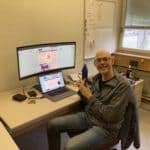Profile
Patrick MacGregor
-
About Me:
I’m a Christian. I live with my wife and daugthter in Switzerland: by day, I’m a nuclear physicist at CERN, by night, I enjoy reading books, playing board games, and watching Star Wars/Harry Potter/Doctor Who/other sci-fi series — but at the moment, I’m mainly doing a lot of baby-related activities (my nickname is the nappy ninja, because I once managed to change my daughter’s nappy at night without her waking up 🥷) I’m also trying to learn French and Mandarin Chinese, but I don’t speak them very well.
-
My pronouns are:
he/him
-
I'm a member of team ISOLDE
-
My Work:
I study nuclear structure. This is working out how protons and neutrons are arranged within atomic nuclei. I am interested in the structure of radioactive nuclei. They’re very hard to study because they keep changing into other atoms!
-
Read more
We can study nuclei by scattering particles off them. In fact, we all do this everyday when we see things! In your classroom to read your book, the light particles from the bulbs (the beam) hit your textbook (the target), interact with it (the reaction), and scatter into your eyeball (the detector). From these particles, you can get information about the textbook (reading!).
Similarly, to study nuclei, we have to scatter particles off them, and detect the scattered particles. Because the nuclei I study are radioactive, I have to scatter particles very quickly before it changes into something else!
The scattering reactions I look at are called “transfer reactions”. This is where a proton or neutron is transferred from one particle to another in a nuclear reaction. We can measure the energy and momentum of the particles that land in our detectors, and work out what the nuclear structure is like.
We can use the nuclear structure to learn more about how nuclei behave. This improves our understanding of nuclear physics, which can then be applied to cancer treatment, nuclear power, how stars work and so on!
I work at the ISOLDE facility at CERN. Here, we create radioactive nuclei that have very short lifetimes (often less than a second!). We fire these radioactive nuclei at our target, where a single neutron or proton is transferred in our transfer reaction. We have to fire them very fast before they change — they travel at about 20% of the speed of light!
The target is placed in an old MRI magnet, which is like a big tube that people can lie inside. They are normally used to take pictures of the body with the strong magnetic field. We use them to contain all the particles that fly out in our reaction, and direct them onto detectors. I have to be very careful that I don’t have anything metal in my hands or pockets when I stand nearby. Otherwise, they get sucked out of my hand and would damage the equipment!
I’m interested in magnesium atoms that have different numbers of neutrons. Stable magnesium has only 12 neutrons, but I’ve been investigating the nuclear structure of magnesium isotopes with 17 and 19 neutrons. Here is a that I created for a competition where scientists present their research to politicians. It contains more information about how the detector works:
https://imascientist.org.uk/wp-content/blogs.dir/505/files/2022/11/stem_for_britain_poster_edit.pdf
-
My work before CERN:
I was actually doing the same kind of job! The experiment I work on has links to a team at the University of Manchester, which is where I was working. Now, I get to work with the same people but at CERN.
In Manchester, I was mainly analysing data, because the equipment was very far away. Now I’m at CERN, I’m able to do more tests with the detectors as well as my data analysis. And I get to work with the same people (but on zoom instead of face to face)
-
What I would like to do next?:
I would love to keep researching nuclear physics, and to plan my own experiments. I am open to going anywhere, as I love exploring places and learning about new languages and cultures (and eating the food!)
-
Education:
Sept 2017 – Sept 2021: PhD student at the University of Manchester
Sept 2013 – June 2017: Integrated masters course at the University of Manchester
2007-2013: GCSEs and A-Levels at the North Halifax Grammar School
-
Qualifications:
PhD nuclear physics
MPhys Physics
A-Levels: Physics, Chemistry, Maths, Further Maths
AS-Levels: Critical Thinking, Geology
GCSEs: Maths, Double Science, English language, English literature, Religious Studies, Technology Graphics, Statistics, French, Latin
-
Work History:
Nov 2022 – present: CERN!
Oct 2021 – Oct 2022: Post-doctoral researcher at the University of Manchester
-
Job title:
Senior Applied Fellow
-
Employer:
CERN
-
My Interview
-
How would you describe yourself in 3 words?
Not a starfish
What did you want to be after you left school?
Any job where I was allowed to do science and play with computers
Were you ever in trouble at school?
Not really - I quite enjoyed lessons
If you weren't doing this job, what would you choose instead?
Something with computers hopefully
Who is your favourite singer or band?
Weird Al? I don't listen to a lot of music, but his songs are quite funny
What's your favourite food?
I LOVE Chinese food
If you had 3 wishes for yourself what would they be? - be honest!
Unlimited wishes? Then I don't have to think too hard 😅. If that's not allowed, then unlimited wish granters 😂
Tell us a joke.
How do you organise a space party? You planet! (*Ba-dum-tiss*)
-


